Related Research Articles

Ida, minor planet designation 243 Ida, is an asteroid in the Koronis family of the asteroid belt. It was discovered on 29 September 1884 by Austrian astronomer Johann Palisa at Vienna Observatory and named after a nymph from Greek mythology. Later telescopic observations categorized Ida as an S-type asteroid, the most numerous type in the inner asteroid belt. On 28 August 1993, Ida was visited by the uncrewed Galileo spacecraft while en route to Jupiter. It was the second asteroid visited by a spacecraft and the first found to have a natural satellite.

Tycho is a prominent lunar impact crater located in the southern lunar highlands, named after the Danish astronomer Tycho Brahe (1546–1601). It is estimated to be 108 million years old.
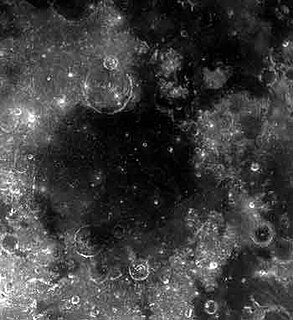
Mare Humorum is a lunar mare. The impact basin it is located in is 425 kilometers across.
This is a directory of lists of geological features on planets excepting Earth, moons and asteroids ordered by increasing distance from the Sun.

A geological formation, or formation, is a body of rock having a consistent set of physical characteristics (lithology) that distinguishes it from adjacent bodies of rock, and which occupies a particular position in the layers of rock exposed in a geographical region. It is the fundamental unit of lithostratigraphy, the study of strata or rock layers.
This is a list of minor planets which have been officially named by the Working Group Small Body Nomenclature (WGSBN) of the International Astronomical Union (IAU). The list consists of partial pages, each covering a number range of 1000 bodies citing the source after each minor planet was named for. An overview of all existing partial pages is given in section § Index.

Apianus is a lunar impact crater that is located on the rugged south-central highlands of the Moon. It is named after 16th century German mathematician and astronomer Petrus Apianus. It is located to the northeast of the crater Aliacensis, and to the northwest of Poisson. The worn crater Krusenstern is attached to the west-northwestern rim.
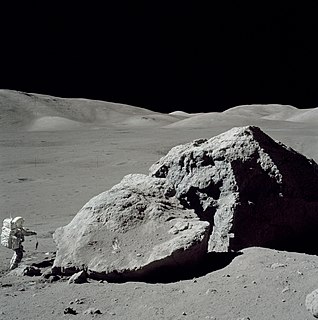
Planetary geology, alternatively known as astrogeology or exogeology, is a planetary science discipline concerned with the geology of the celestial bodies such as the planets and their moons, asteroids, comets, and meteorites. Although the geo- prefix typically indicates topics of or relating to Earth, planetary geology is named as such for historical and convenience reasons; due to the types of investigations involved, it is closely linked with Earth-based geology. These investigations are centered around the composition, structure, processes, and history of a planet.

The Flora family is a prominent family of stony asteroids located in the inner region of the asteroid belt. It is one of the largest families with more than 13,000 known members, or approximately 3.5% of all main-belt asteroids.
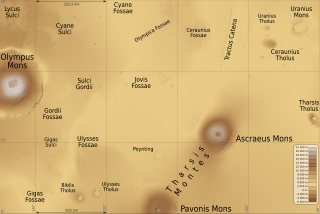
In planetary nomenclature, a tholus is a small domical mountain or hill. The word is from the Greek θόλος, tholos, which means a circular building with a conical or vaulted roof. The Romans transliterated the word into the Latin tholus, which means cupola or dome. In 1973, the International Astronomical Union (IAU) adopted tholus as one of a number of official descriptor terms for topographic features on Mars and other planets and satellites. One justification for using neutral Latin or Greek descriptors was that it allowed features to be named and described before their geology or geomorphology could be determined. For example, many tholi appear to be volcanic in origin, but the term does not imply a specific geologic origin. Currently, the IAU recognizes 56 descriptor terms. Tholi are present on Venus, Mars, asteroid 4 Vesta, dwarf planet Ceres, and on Jupiter's moon Io.

A minor planet is an astronomical object in direct orbit around the Sun that is neither a planet nor exclusively classified as a comet. Before 2006, the International Astronomical Union (IAU) officially used the term minor planet, but during that year's meeting it reclassified minor planets and comets into dwarf planets and small Solar System bodies (SSSBs).
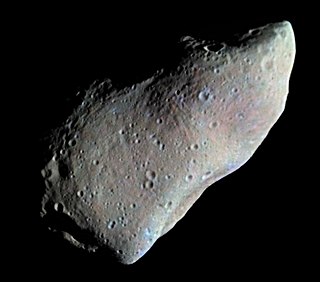
951 Gaspra is an S-type asteroid that orbits very close to the inner edge of the asteroid belt. Gaspra was discovered by Russian astronomer G. N. Neujmin in 1916. Neujmin named it after Gaspra, a Black Sea retreat that was visited by his contemporaries, such as Gorky and Tolstoy.
Gaspra is a spa town, an urban-type settlement in Yalta Municipality in the Autonomous Republic of Crimea, a territory recognized by a majority of countries as part of Ukraine and incorporated by Russia as the Republic of Crimea. It is located on the Black Sea coast, west of Yalta, and is a popular holiday resort. Population: 10,310 .

Huang Jiqing, also known by his courtesy name Huang Degan, was a Chinese geologist. He was born March 30, 1904 in Renshou, Sichuan to an intellectual family. In 1928 he obtained his bachelor's degree at Peking University, and in 1935 he got his PhD at University of Neuchâtel, Swiss. After returning to China he taught at National Central University and Peking University, and served as director of the National Geological Survey, president of the Geological Society of China, director of the Southwest Geological Bureau, deputy director of the Academic Division of Earth Sciences of the Chinese Academy of Sciences, deputy president of the Chinese Academy of Geological Sciences. In 1980 Huang received an honorary doctorate from the ETH Zurich, and in 1985 he was elected as an honorary member of Geological Society of America.
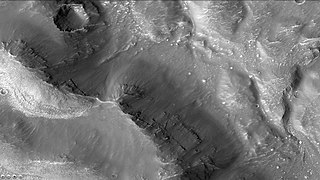
Lampland is an impact crater on Mars, located in the Thaumasia quadrangle at 35.9°S latitude and 79.6°W longitude. It is 79.0 kilometers in diameter and was named after Carl Otto Lampland. The name was approved by IAU's Working Group for Planetary System Nomenclature in 1973.

Rayleigh is an impact crater in the Mare Australe quadrangle of Mars, located at 75.6°S latitude and 240.9°W longitude. It measures approximately 126 kilometers in diameter and was named after English physicist Lord Rayleigh. The name was approved by the International Astronomical Union (IAU) Working Group for Planetary System Nomenclature in 1973.